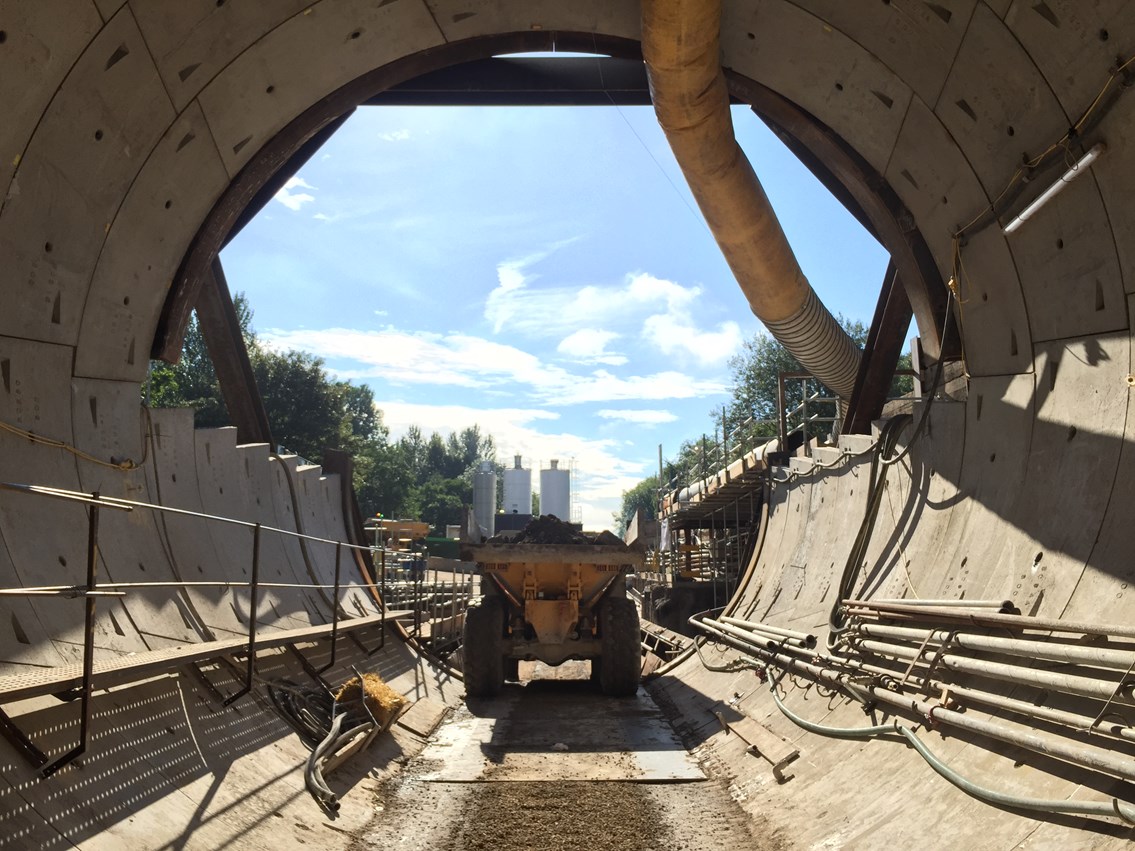Friday 4 Sep 2015
Farnworth Tunnel engineers battle to overcome poor ground conditions
- Region & Route:
- | North West & Central
A complex tunnelling project to enable electric trains to run between Bolton and Manchester has been delayed, possibly until December, by exceptionally poor ground conditions.
Network Rail engineers enlarging the 1834-built Farnworth Tunnel have run into large swathes of sand. Rather than a firm material to bore through, sand pours down into the excavated area halting progress.
It has proved impossible to safely excavate while concurrently installing and grouting sections of tunnel wall as was originally planned.
Engineers are now pumping resin into the ground to firm it up before 9m-wide Fillie, the UK’s largest tunnelling machine, bores through it.
For local train passengers the railway between Bolton and Manchester will continue to operate as it has since May.
Martin Frobisher, route managing director for Network Rail, said: “This delay is intensely frustrating for our engineers and, more importantly, for passengers who are set to benefit from more frequent, faster, quieter services once this wider programme of work is complete.
“We are doing the best we can in difficult circumstances and we are sorry it is taking longer than we first thought and impacting on passengers.
“We first hit an area of running sand on August 14 when our engineers saw it suddenly pouring from the working face. This has slowed progress and created big voids, the largest of which needed filling with around 35 tonnes of grout. Again on August 27, sand poured into the excavated area and our engineers had to remove 100 tonnes of material by hand.
“The nature of civil engineering, especially deep below ground, is that you never fully know the exact ground conditions until you start tunnelling or excavating. Taking soil samples acts as a guide but is never 100% accurate because conditions vary greatly with the amount of water present.
"The rate of progress is very dependent upon the conditions and we are working around the clock to complete this as quickly as possible.
“Our top consideration is safety. Our engineers face a huge challenge. We must allow them the time they need to tackle it safely. We will of course provide further updates over the coming weeks when we know more."
Nick Donovan, managing director at First TransPennine Express, said: "Throughout the duration of the vital electrification programme at Farnworth Tunnel, we have worked very closely with Network Rail to ensure our customers remain informed and are kept moving.
"While the tunnelling being more challenging than anyone expected is disappointing, we will continue to focus our efforts on delivering train services until the work is completed.”
Alex Hynes, managing director for Northern Rail, said: “We are deeply disappointed that work to deliver the Farnworth Tunnel project will now not be completed by October 5, as originally planned. This will have a significant impact on the lives of our daily commuters.
“No matter what, we will continue to work with Network Rail and First TransPennine Express and do our utmost to keep our customers up-to-date with the latest developments as and when they happen.”
Northern Rail and First TransPennine Express services will continue as planned until October 5. The train plan after this date is currently being determined.
ENDS
Notes to editors:
• The original Farnworth Tunnel was built in 1834. It was built to accommodate a single track for steam-powered trains.
• It is being enlarged by a 9m-wide drilling machine so it can in future house two tracks with overhead electric equipment to enable electric trains to run through it.
• Tunnelling started on August 1 and was originally planned to be completed by October 5.
• More than 1,500 soil samples have been taken, each one eight metres in depth, to try and get as accurate an idea as possible of the ground conditions to be encountered, but such testing can only ever act as a guide.
• Fillie, built in Oldham, was expected to be able to tunnel 5.6m to 7m every 24hrs. But because of the very poor ground conditions, she has only been able to bore at a rate of 2.8m / 24hrs.
• Farnworth tunnel is 276m long and, as at September 2, 45m had been excavated since tunnelling started on August 1, leaving a further 231m to go.
• On the assumption that the rate of tunnelling stays as it is now, completion will be December.
Contact information
Passengers / community members
Network Rail national helpline
03457 11 41 41
Latest travel advice
Please visit National Rail Enquiries
Journalists
Network Rail press office - North West & Central Region
0330 854 0100
NWCmediarelations@networkrail.co.uk
About Network Rail
We own, operate and develop Britain's railway infrastructure; that's 20,000 miles of track, 30,000 bridges, tunnels and viaducts and the thousands of signals, level crossings and stations. We run 20 of the UK's largest stations while all the others, over 2,500, are run by the country's train operating companies.
Usually, there are almost five million journeys made in the UK and over 600 freight trains run on the network. People depend on Britain's railway for their daily commute, to visit friends and loved ones and to get them home safe every day. Our role is to deliver a safe and reliable railway, so we carefully manage and deliver thousands of projects every year that form part of the multi-billion pound Railway Upgrade Plan, to grow and expand the nation's railway network to respond to the tremendous growth and demand the railway has experienced - a doubling of passenger journeys over the past 20 years.
Follow us on Twitter: @networkrail
Visit our online newsroom: www.networkrailmediacentre.co.uk

